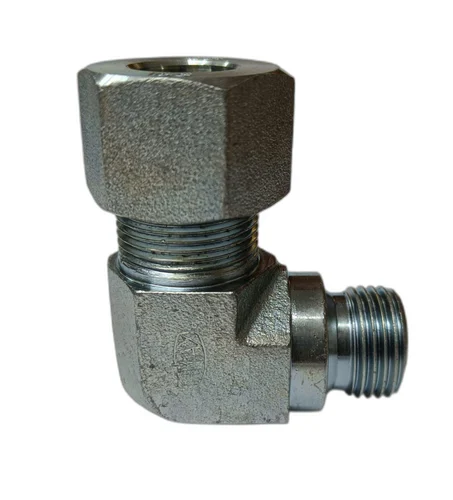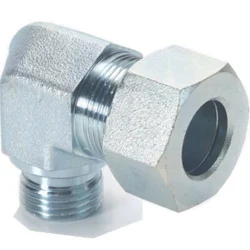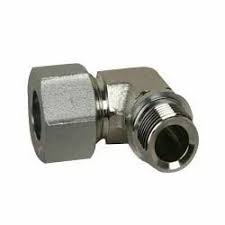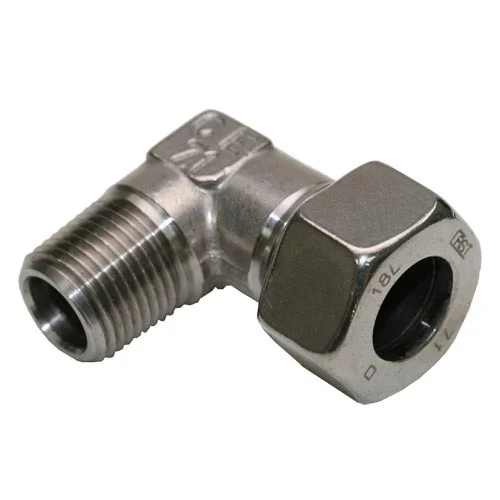Contact : +91-79045 61980 | Email: hydrofitengineers@gmail.com




Hydraulic Male Stud Elbow
A hydraulic ferrule type male stud elbow is a type of hydraulic fitting that is used to connect hydraulic tubes or pipes together at an angle. This fitting is commonly used in hydraulic systems where flexibility is required in the positioning of hydraulic lines or where space is limited. The ferrule type refers to the type of sealing mechanism used to ensure a secure and leak-free connection between the tube or pipe and the fitting.
Components of the Male Stud Elbow Assembly
The hydraulic ferrule type male stud elbow consists of basically three components – the body, the ferrule and the nut. The body is the main part of the fitting and is designed to accommodate a tube or pipe at one end and the other male thread goes into the female connection of a valve or a manifold. The tube end connection and the male thread connection are at an angle of 90 deg.
Size Range of Male Stud Elbow
The hydraulic ferrule type male stud elbow is available in a range of sizes and materials to accommodate different hydraulic systems and applications. The size of the fitting is determined by the diameter of the tubes or pipes being connected, and the material of the fitting is typically chosen based on the specific needs of the application.
Material of Construction Male Stud Elbow
Some common materials used for hydraulic fittings include:
- Carbon Steel : This is the basic material for the hydrauic male stud elbow as it strong and robust and withstands high pressure. It’s low cost and machinibility also makes it the material of choice.
- Stainless steel: Stainless steel is chosen for corrosive or chemical appications. SS is highly resistant to corrosion and is used in applications where the hydraulic fluid is corrosive or the fitting is exposed to harsh environmental conditions.
- Brass: Brass fittings are often used in low-pressure applications where corrosion resistance is not as critical. Brass fittings are also commonly used in applications where the fitting needs to be easily accessible for maintenance or repairs.
Factors to consider when selecting the Size and Material of Male Stud Elbow
When selecting a hydraulic ferrule type male stud elbow, it is important to consider several factors to ensure that the fitting is suitable for the specific needs of the application. Some of the key factors to consider include:
- Tube or pipe size: The size of the tubes or pipes being connected will determine the size of the fitting needed. It is important to select a fitting that is compatible with the size of the tubes or pipes being used in the hydraulic system.
- Angle of connection: The angle of the connection required will determine the type of elbow fitting needed. Different angle fittings are available to accommodate different angles of connection.
- Pressure rating: The fitting should be rated to handle the maximum pressure of the hydraulic system. Choosing a fitting with a lower pressure rating can lead to failure or damage to the system.
- Material compatibility: The material of the fitting should be compatible with the type of hydraulic fluid being used in the system. Choosing a fitting that is not compatible with the fluid can lead to corrosion or other issues.
- Temperature range: The fitting should be able to withstand the temperatures associated with the hydraulic system. Choosing a fitting that is not able to withstand the temperatures can lead to failure or damage to the system.
- Environmental factors: The fitting should be able to withstand any environmental factors, such as exposure to chemicals, moisture, or other contaminants, that may be present in the hydraulic system.
In conclusion, the hydraulic ferrule type male stud elbow is a reliable and durable option for connecting hydraulic tubes or pipes together at an angle in hydraulic systems. The ferrule type sealing mechanism provides a secure and safe connection.
